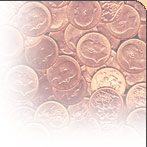Value of Coins
Many collectors have come across a particular coin from time to time and wondered whether they had something of great value in their possession. This feature describes the main factors influencing coin values and provides some guidance in obtaining an estimate of coin values. Remember, however, that the mere fact that a coin does not have significant monetary value does not mean that it is not interesting or that it should not form part of your coin collection.

Latest Coin Values
You can buy American Gold Coins, Canadian Coins and Russian Coins at My Coin Dealer shop.
There are several sources where you can find latest coin values :
This web site: we are trying to find sources of latest coin prices and publish it on this web site. These prices are updated regularly and available in following sections: Coin Catalog (American Coin value, Canadian Coin values, British Coin values and some foreign coin values), Gold Coins Prices, US Coin Values.
TopFactors Influencing Coin Values
The coin values are influenced or determined primarily by the following five factors:
Old Coin Values and Rare Coin Values:
Scarcity or rarity is a major determinant of coin value.
As a general matter, the rarer a coin the higher the coin value. Note that rarity has little to do with the age of a coin. Many one thousand year old Chinese coins often sell for no more than a few dollars because there are a lot of them around, whereas a 1913 Liberty Head Nickel may sell for over $1,000,000 because there are only five known specimens in existence.
The condition or grade will influence coin value.
The better the condition a coin is in, the higher will be its assigned grade and the more it will be worth. An uncirculated coin that is in flawless mint state might be worth hundreds times more than the same coin in good condition but which has been circulated.
Please refer to the Coin Grading page for more information about coin grades.
Gold Coin Values, Silver Coin Values: Many coins have a bullion value determined by the value of the precious metals it contains. A gold coins, silver coins or platinum coin does not generally sell for much less than its melt value.
The demand for the particular coin, or how many collectors want it, will also greatly influence coin values. Some coins that are relatively plentiful may command higher prices than scarcer coins because the former are more popular with collectors. For example, there are over 400,000 1916 D dimes in existence as compared to only about 30,000 1798 dimes. However, even though the 1798 dime is much rarer than its 1916D counterpart, the 1916D coin sells for significantly more. This is because many more people collect early 20th century mercury dimes than dimes from the 1700's.
Rarity and grade do not tell the whole story in a coin's value. The "quality" of coins is a huge factor in determining coin value and coin price when you decide to sell. But it is also the most difficult to determine properly, and requires a practiced eye.
Obviously, all coins are not all the same aesthetically. Some coin designs -- the high relief Saint-Gaudens Double Eagle, for example -- are widely considered to be more beautiful than others. The public's taste for these designs has a significant influence on the value of the coins that bear them.
But when we speak of a coin's "quality," we are talking about characteristics of minting, execution, survival condition, and overall eye appeal that set it apart from other coins of the same design and certified grade. Individual coins that are above average in appearance for strike, luster, evenness and/or color of toning, and eye appeal are considered to be higher in quality, and simply in greater demand, than those that do not look as nice-even at the same PCGS or NGC rating. The higher the quality, the greater the value of any particular issue.
Furthermore, some coins grade at the top of their rating while others grade at the bottom, even though they are identical on paper. These differences within grade are usually small but nonetheless observable to the expert eye, and are an important factor in quality and value. Coins that are higher in quality always sell faster and usually command higher prices than other coins at each grade rating. The quality of your rare coins is therefore is quite important, not merely for your own aesthetic enjoyment but also for the value and liquidity of your investment.

